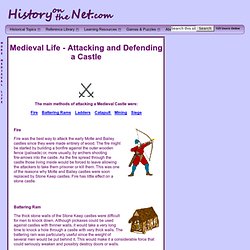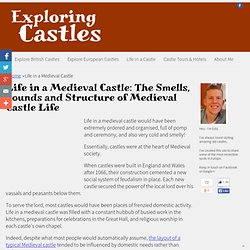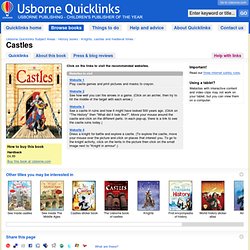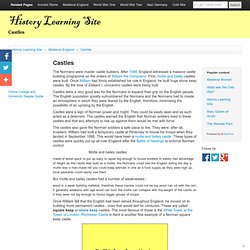

Medieval Life - Attacking and Defending a Castle. The main methods of attacking a Medieval Castle were: Fire Battering Rams Ladders Catapult Mining Siege Fire Fire was the best way to attack the early Motte and Bailey castles since they were made entirely of wood.

The fire might be started by building a bonfire against the outer wooden fence (palisade) or, more usually, by archers shooting fire-arrows into the castle. As the fire spread through the castle those living inside would be forced to leave allowing the attackers to take them prisoner or kill them. Battering Ram The thick stone walls of the Stone Keep castles were difficult for men to knock down. Ladders Ladders were used by those attacking a castle to climb over the walls and fight the castle inhabitants within the castle walls. The Belfry was a large structure on wheels that could be pushed up to the castle walls. Catapult Mining A good way of attacking a stone castle was through mining. Siege Another good way of attacking a stone castle was by placing it under siege. Activities. Life in a Medieval Castle: The Smells and Sights of Castle Life. However, of course, life in a Medieval castle would have also included military activities.

On many days, knights would have practiced their skills to defend their lord - and his king - in battle. Preparations were made to defend the castle in case it came under siege, and machinery was made to defend the castle in times of attack. Castles were constantly re-designed and adapted to provide the best possible defence against new and unwelcome threats.
There were many different obstacles built to defend Medieval castles. These obstacles included everything from moats (sometimes with spikes within) to gatehouses which contained all manner of obstacles, tricks and traps. Some castles occasionally even housed prisoners in their dungeons. The damp dungeons of Chillon Castle in Switzerland are brilliantly atmospheric. “Castles” in Usborne Quicklinks. Quicklinks Click on the links to visit the recommended websites.

Important! Read our three internet safety rules. Internet safety Children, make sure you follow these three simple rules when using the internet: Always ask an adult's permission before using the internet.Never give out personal information, such as your name, address, school or telephone number.If a website asks you to type in your name or email address, check with an adult first. For more tips, see Internet safety for children. Adults - we recommend that children are supervised while on the internet. For more on internet safety, see Internet advice for adults. Using a tablet? Websites with interactive content and video clips may not work on your tablet, but you can view them on a computer. About this book. Castles. The Normans were master castle builders.

After 1066, England witnessed a massive castle building programme on the orders of William the Conqueror. First, motte and bailey castles were built. Once William had firmly established his rule in England, he built huge stone keep castles. By the time of Edward I, concentric castles were being built. Castles were a very good way for the Normans to expand their grip on the English people. Castles were a sign of Norman power and might. The castles also gave the Norman soldiers a safe place to live.
Motte and bailey castles: made of woodquick to put upeasy to repairbig enough to house soldiers in safetyhad advantage of height as the castle was built on a motte; the Normans could see the English during the daya motte was a man-made hillyou could keep animals in one as a food supplyas they were high up, local peasants could easily see them But motte and bailey castles had a number of weaknesses : Parts of a Castle. Castle View.
Facts about Castles - Homework help. From early times, people have built protection around them.

Stone Age people lived in caves and made defences to keep out wild animals. The first cities built had high stone walls to keep out invaders. Kings and nobles fortified their large large homes to protect themselves. What are castles? | Why were castles built? What is the biggest castle in England? Rochester Castle, Kent The great age of castles began almost 1,000 years ago and lasted for nearly 500 years.